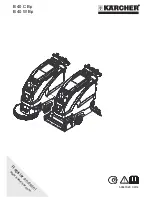
-
13
Petrol engine/diesel engine
: Close
fuel cock.
Gas engine
: Close the gas supply.
Secure the wheels of the machine with
wheel chocks.
Secure the machine with tensioning
straps or cables.
Note:
Observe markings for fixing
points on the base frame (chain sym-
bols). Only unload the appliance on lev-
el grounds.
Remove KIK-key.
Disconnect the battery of the sweeper
during transport.
Park the sweeper on a level surface in
a dry, frost protected area. Protect it
against dust by means of covering ma-
terial.
Turn the program selection switch to
"OFF".
Remove KIK-key.
Lock the sweeper to ensure that it does
not roll off.
Gas engine
WARNING
Machines must always be parked safe-
ly.
The machine - particularly the liquid gas
container and its connections - must be
inspected by a qualified person at regu-
lar intervals, as required by the regional
or national guidelines for safe opera-
tion.
Additionally observe the following points if
the sweeper is not used over a longer peri-
od of time:
Change engine oil.
Diesel engine
: Either completely drain
the fuel tank or completely fill it with fu-
el.
Close fuel cock.
Let the engine turn without starting it
every 6 months.
Petrol engine
: Close the fuel cock, re-
move the fuel hose from the fuel cock.
Open the fuel cock and completely
drain the fuel into a suitable container.
Then attach the fuel hose and close the
fuel cock.
Unscrew the spark plug and put 5 ml of
engine oil in the spark plug bore. Rotate
the engine several times without the
spark plug (do not start). Screw in the
spark plug.
Gas engine
: Close the gas supply.
Unscrew the gas hose with union nut
(use 30 mm spanner).
Lock the gas bottle with the safety cap
and store upright in a suitable storage
area (also see Chapter "Safety instruc-
tions).
Unscrew the spark plug and put 5 ml of
engine oil in the spark plug bore. Rotate
the engine several times without the
spark plug (do not start). Screw in the
spark plug.
Clean the inside and outside of the
sweeper.
Park the machine in a safe and dry
place.
Turn the program selection switch to
"OFF".
Remove KIK-key.
Set the main switch to the "0" position.
Activate parking brake.
Disconnect the negative terminal of the
battery if the appliances is not used for
more than 4 weeks.
Figure is symbolic
Charge battery approx. every 2 months.
– Maintenance work may only be carried
out by approved customer service out-
lets or experts in this field who are famil-
iar with the respective safety regula-
tions.
– Mobile appliances used for commercial
purposes are subject to safety inspec-
tions according to VDE 0701.
– Use only roller brushes/ side-brushes
that are provided with the appliance or
specified in the Operations Manual.
The use of other roller brushes/ side-
brushes can affect the safety of the ap-
pliance.
– The battery installed in the appliance is
maintenance-free.
DANGER
Risk of personal injury or damage!
First switch off the device and remove
the KIK-key (Kärcher Intelligent Key)
before performing any cleaning or
maintenance tasks on the device, re-
placing parts or switching over to anoth-
er function.
Always disconnect the battery when
working on the electrics.
Turn the program selection switch to
"OFF".
Remove KIK-key.
ATTENTION
Using non-rechargeable batteries is prohib-
ited.
Only use batteries and chargers approved
by the manufacturer.
Replace batteries with the same battery
type only.
Prior to disposal of the vehicle, the batter-
ies must be removed and disposed of in ac-
cordance with local regulations.
ATTENTION
Follow accident prevention regulations as
well as DIN VDE 0510, VDE 0105 T.1.
Please observe the following warning notes
when handling batteries:
DANGER
Risk of fire and explosion!
Do not place tools or similar items on
the battery. Risk of short-circuit and ex-
plosion.
Smoking and open flames must be
strictly avoided.
Rooms where batteries are charged
must have good ventilation because
highly explosive gas is emitted during
charging.
Danger of causticization!
Use caution with leaking batteries (sul-
phuric acid may leak).
Risk of injury!
Storage/decommissioning
Care and maintenance
General notes
Battery
Safety notes regarding the batteries
Observe the directions on the
battery, in the instructions for
use and in the vehicle operat-
ing instructions!
Wear an eye shield!
Keep away children from acid
and batteries!
Risk of explosion!
Fire, sparks, open light, and
smoking not allowed!
Danger of causticization!
First aid!
Warning note!
Disposal!
Do not throw the battery in the
dustbin!
40
EN
Summary of Contents for KM 105/100 R G
Page 2: ...2...
Page 284: ...2 www kaercher com StVZO 284 EL...
Page 285: ...3 KM 105 1xx 18 16 12 KM 125 130 16 12 10 3 4 285 EL...
Page 286: ...4 HVBG DIN 51622 90 10 30 70 0 32 F BGG 936 33 37 UVV BGV D34 1 Nekal 286 EL...
Page 287: ...5 TRF 1996 DA BGV D 34 4 DA BGV D34 2 KIK K rcher Intelligent Key 3 4 5 2 1 2 287 EL...
Page 292: ...10 O 2 1 2 KM 125 400 kg 608 kg 292 EL...
Page 294: ...12 20 kg KIK 1 OFF 1 5 C 1 1 5 ON KIK 5 1 2 0 6 cm 294 EL...
Page 295: ...13 6 cm 3 2 1 ECO 2 MEDIUM 3 HEAVY 4 2 ECO KIK D E F 2 50 mm F 15 1 295 EL...
Page 296: ...14 D E F C 1 4 1 2 3 4 OFF K KIK OFF KIK 6 5 ml K 296 EL...
Page 298: ...16 0 K rcher 100 20 200 K rcher 20 100 200 300 3 4 OFF KIK 298 EL...














































